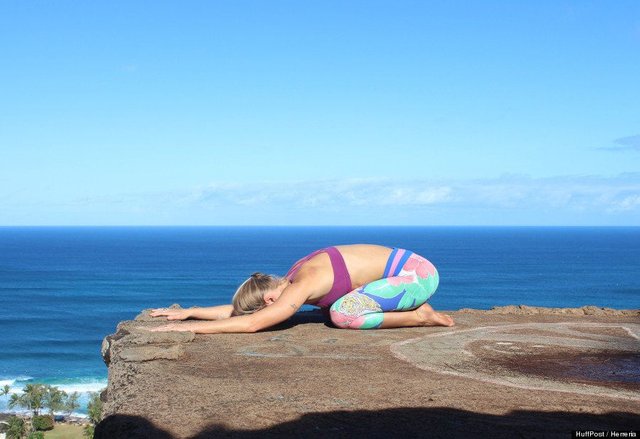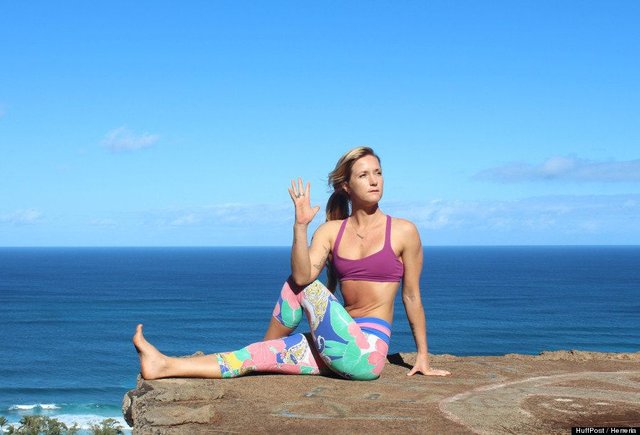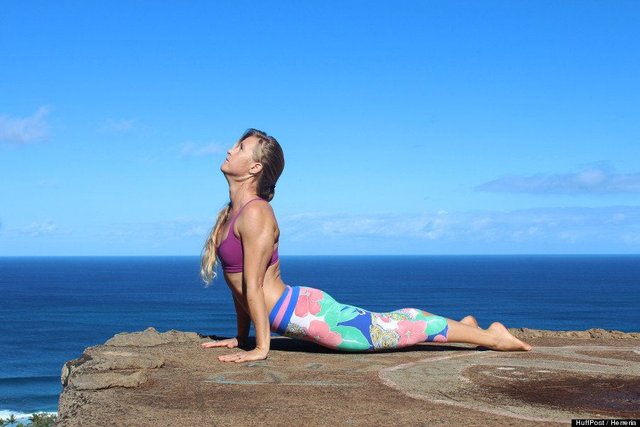BASIC POSITIONS OF YOGA
Here are 11 basic yoga positions that can be done and define the flexibility you have, so you will stretch your joints and adapt better to the different yoga positions more advanced.
you can do this sequence every day for 45 minutes, repeating the sequence until the time is up
Hold each position for three to five slow and deep breaths, inspire and exhale through the nose.
- Mountain Pose (Tadasana)
Stand up, keep the spine firm with the feet parallel and the thumbs in contact. Look forward.
Unlike when you usually stand, now stand up with a purpose, feel the four corners of your feet, raise the kneecaps, distribute the weight between the legs and turn them inwards, bring the tailbone back and lift the belly button up and inward Relax your shoulders in the direction of your lower back and turn your palms forward. Imagine that you carry heavy stones in your hands, look straight ahead and feel the power of the Mountain!
Common mistakes: Ribs and buttocks should not protrude too much. Try to keep the spine in a straight line.

- Chair posture (Utkatasana)
The knees flexed at the ankle, the thighs as parallel to the floor as possible. The torso should form a right angle with the thighs. Bring your feet close to form a more advanced posture. Breathe in as you raise your hands. Move more weight to your heels to pull your knees so they don't come in front of your feet.
Common mistakes: The knees should not be ahead of the feet.

- Foot clamp (Uttanasana)
This posture opens the back of the legs, facilitates the decompression of the spine and allows oxygenated blood to move from the heart to the head.
Start with the mountain posture. Fold along the vertex of your waist and exhale as you descend the torso, keeping the spine as straight as you can. Let the head hang by its own weight and relax the jaw. Keep your feet apart at hip height, if you are a beginner, or your feet together if you are an intermediate or advanced student. Perseverance in yoga is important and, over time, the back side of the legs will open with this foot clamp. Keep your knees soft and don't block them
Common mistakes: Keeping the spine firm is more important than having straight legs. Bend your knees as much as necessary to keep your back straight and your chest in contact with your thighs.

- Dog pose down (Adho Mukha Svanasana)
This inversion opens the body completely. Starting with an iron position, keep your arms straight at the height of your shoulders and feet at the width of your hips. Lift your hip toward the sky and exhale until your body reaches the position of an inverted V. The eyes look between the legs and towards the belly. Pull the belly and ribs inward. It is more important to keep your back straight than your legs. "You should not hesitate to bend your knees or lift your heels if necessary." Imagine you are a fish, you have been hooked Hook by the coccyx and they pull you towards the boat. This will help you lift your hips up and back.
Common mistakes: People with hamstrings and tight calves tend to form box-shaped poses. To correct this, bend your knees further and direct your chest toward the beginning of your thighs, while pressing your hands firmly against the floor to pull your hips back.

- Warrior 1 position (Virabhadrasana 1)
From the dog down, forward your right foot between your hands, turn your left heel inward and lift your torso and arms up. Inhale The heel of the front foot should be aligned with the arch of the back foot, with the front of the knee directly on the ankle. Direct both hips forward, bend the coccyx and pull the ribs inwards. Repeat the posture with the opposite part of the body. Imagine that your hips are your two headlights. You want your headlights to look forward
Common mistakes: The entire waist should face forward, not outward, and the rear foot should approach at an angle of 45 degrees and not at one of 90.

- Warrior 2 posture (Virabhadrasana 2)
Similar to warrior one, but with arms stretched in opposite directions, parallel to the ground and in line with the shoulders. Raise your arms and torso and inhale. The back foot should form a 90 degree angle and the front thigh should be parallel to the floor, with the knee directly on the ankle. The eyes should look over the middle finger. Repeat the posture with the opposite side of the body. Imagine you are stretching your mat. To align the hips, put your hands on them to make sure you don't lean too much on any hips
Common mistakes: The ass and belly should not protrude and an arch should not form at the end of the back. Alignment of the feet is also a common mistake. Make sure the heel of your front foot aligns with the arch of your back foot.

- Triangle posture (Trikonasana)
Separate the feet well creating a triangle from the feet to the pelvic bone. Start by turning one foot 90 degrees outward and the other in 15 degrees. Stretch your arms in line with your shoulders and, while exhaling, lower your torso towards the foot you have turned outward. For beginners, the fingers should touch the shin; For more advanced, you should touch the ground lightly. The other arm should stretch upward with the eyes looking at the tip of the elongated fingers; keep the neck long and separate from the shoulders. The shoulders and arms should be in line. To ensure good alignment, perform the posture very slowly.
Common mistakes: The front hip should not stand out and the rear hip should not fall.

- Child's position (Balasana)
The child's posture is a pose of submission. Starting from a kneeling position, with the tips of the feet touching and the knees at shoulder height, lower the waist to the ankles while extending the arms forward, on the floor, and lower the forehead also towards the ground. Close your eyes and rest your forehead on the floor. Breathe in the way that is most comfortable for you. There is no wrong way to do the child's posture. However, if you have tight thighs, it may be helpful to place a blanket or pillow between your thighs and ankles and something to rest your forehead on.

- Half cobra (Ardha Bhujangasana)
This posture is executed on the belly, with the pubic bone and the insteps pressing against the ground. The feet stretch well back and apart at the height of the hips. The hands are deposited on both sides of the ribcage and the elbows are pressed back, as if moving towards each other. Using the strength of the lumbar muscles, the chest and upper ribs take off from the floor. Inhale while you wake up, breathe a few times and exhale as you descend. The shoulders should form a 45-degree angle and you should use the lower back to exert force - with a minimum impulse of the hands - to detach your torso from the ground.
Common mistakes: The hands should not go forward to the shoulders and the shoulders should not be next to the ears. To correct it, pull these back and away from your ears.

- Marichi Pose (Marichyasana)
A rotation posture with an extended leg, dedicated to the wise Hindu Marichi. Rotating the column in the sitting position neutralizes the column. Start from a sitting position, with your ass on the floor and both legs in parallel in front of you. Fully extend your left leg and flex your foot towards you. Bend your right knee and cross your right foot over the extended left leg. The left elbow pushes against the outside of the right knee, the right hand is placed on the floor in the right part of the body. The right hand should be planted behind the right side of the spine, giving support. Look over your shoulder or as much as your neck allows. Repeat the pose with the opposite side of the body. Exhale as you rotate the spine. Inhale to create space [in your torso] and exhalation will introduce you more into the space you have created
Common mistakes: Do not bend your back. Stretch the spine by raising your back. Make sure the back hand is helping to raise the spine.

- Dog pose up (Urdhva Mukha Svanasana)
From an iron position, with the feet apart at the height of the hips and the arms separated under the shoulders, exhale and use the arms so that the body descends slowly until the elbows form an angle of 90 degrees. Use the tip of your feet to lean your body forward and then turn your feet so that the instep rests flat on the floor. While you inhale, force your elbows so that the entire torso, knees and thighs are lifted off the floor. The hands and feet should be the only parts of the body in contact with the ground. Look up slightly, beyond the tip of the nose. Get out of the position while exhaling.For those determined to dominate the dog up, make sure that you put enough pressure down with your feet and that you take out your chest well using your arms. Get up from the center of the heart while pulling your shoulders down your back
Common mistakes: "I often see students jump into this position before their back is ready for it. It shows well when their shoulders are high and at the height of their ears. I recommend that beginners begin with the cobra's posture, which is closer to the ground. The cobra barely carries weight on the hands and will slowly reinforce the back. "

Remember that during and at the end of the session you should slow it down and in every moment a soft breath, otherwise it can make you dizzy ... I hope it is useful.
Namaste
Hi! I am a robot. I just upvoted you! I found similar content that readers might be interested in:
https://www.huffpost.com/entry/basic-yoga-poses_n_6567444
Congratulations @arianaguillen! You have completed the following achievement on the Steem blockchain and have been rewarded with new badge(s) :
You can view your badges on your Steem Board and compare to others on the Steem Ranking
If you no longer want to receive notifications, reply to this comment with the word
STOPVote for @Steemitboard as a witness to get one more award and increased upvotes!